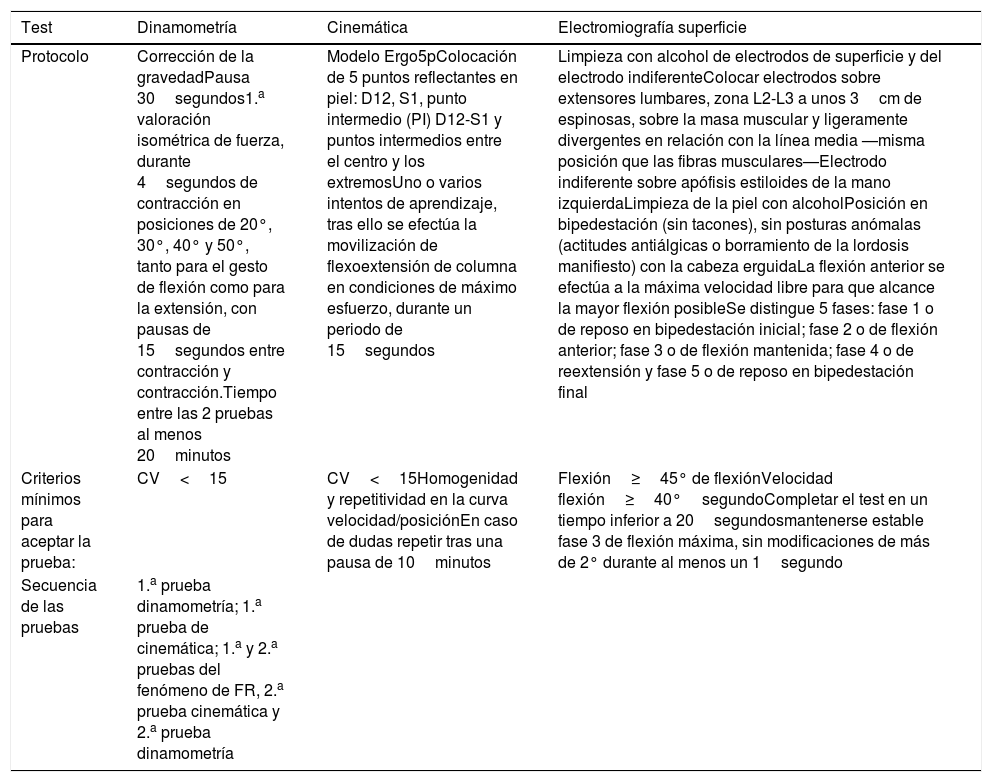Definir el papel del fenómeno de flexión-relajación (FR), valorado mediante ratios (FRR), como test diagnóstico para definir una situación de déficit (impairment) en pacientes con dolor lumbar crónico (DLC).
Material y métodoLa muestra del estudio consta de 180 sujetos, 16 voluntarios sanos y 164 pacientes en situación de incapacidad laboral por DLC, que fueron remitidos consecutivamente desde enero de 2012 a diciembre de 2017 para su valoración al laboratorio de biomecánica de una mutua de accidentes de trabajo. Las evaluaciones consistieron en un test de dinamometría isométrica, una prueba cinemática y una valoración del fenómeno FR. Se establecieron unos criterios mínimos en la ejecución de los test para ser aceptados como pruebas válidas para el estudio. El estado de déficit lumbar o de recuperación clínica en un paciente se definió a partir de los test de dinamometría y de cinemática. La respuesta FR se valoró con los FRR. Se tomaron un total de 4 ratios diferentes para el análisis con curvas ROC.
ResultadosSe obtuvieron 86 pruebas válidas (16 clasificadas como déficit lumbar y 71 como casos recuperados). La mejor ratio obtiene un área bajo la curva ROC de 0,87, una S: 0,84 y una E: 0,87 para identificarlos y un valor predictivo positivo del 97%.
ConclusionesEl test FR guarda con las evaluaciones de dinamometría y de cinemática una alta coherencia para objetivar una situación de déficit, siendo este una prueba de fácil ejecución por parte de los pacientes con DLC.
To define the role of the flexion-relaxation phenomenon (FRP), assessed through ratios (FRR), as a diagnostic test to define impairment in patients with chronic low back pain (CLBP).
Material and methodThe study sample consisted of 180 participants (16 healthy volunteers and 164 patients on work disability due to CLBP), who were consecutively referred for evaluation at the Biomechanics Laboratory of a workplace accident insurance company from January 2012 to December 2017. The evaluations consisted of an isometric dynamometry test, a kinematic test and assessment of the FRP phenomenon. Minimum criteria were established in the performance of the tests for their acceptance as valid for the study. Lumbar impairment or clinical recovery was defined on the basis of the results of the dynamometry and kinematic tests. The FRP response was assessed with FRRs. A total of 4 different ratios were taken for analysis with ROC curves.
ResultsA total of 86 valid tests were obtained (16 classified as lumbar impairment and 71 as recovered cases). The best ratio obtained an area under the ROC curve of 0.87, with a sensitivity of 0.84, a specificity of 0.87, and a positive predictive value of 97%.
ConclusionsThe FRP test, along with dynamometry and kinematic evaluations, is effective in identifying lumbar impairment and is the easiest test for patients with CLBP to perform.















